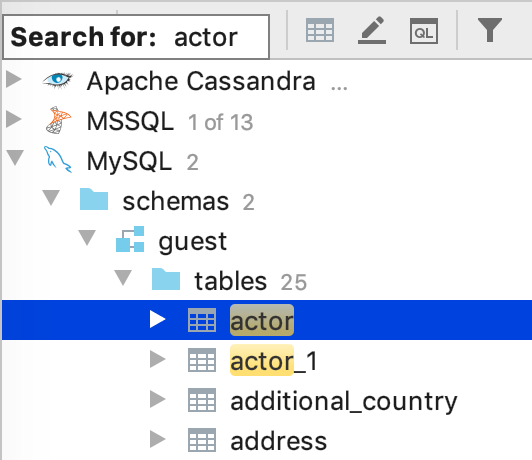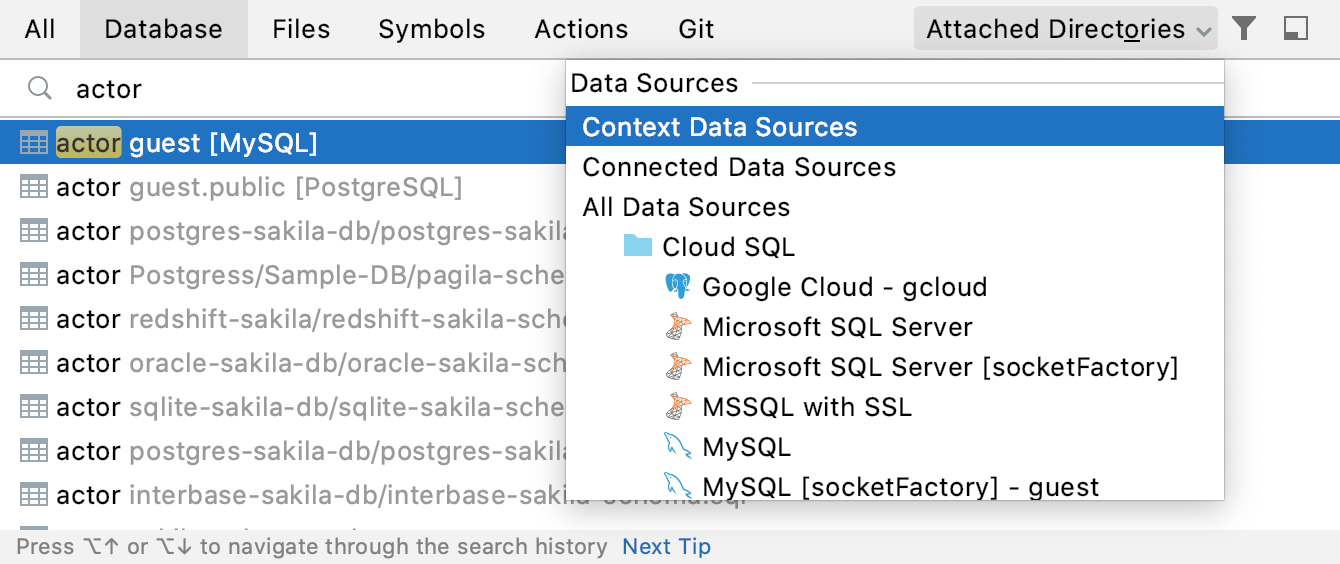Searching Everywhere
DataGrip makes it possible to look for any item of the source code, databases, actions, elements of the user interface, and so on in a single action. If there are no search results found, DataGrip displays a link to Find in Files.
The following video gives a short overview of search everywhere functionality in DataGrip.
Refer to Search for a target within a file for more details about searching text within your project.
Find an object in the database tree view
You can search for any object in the Database Explorer. Click any item in the Database tool window and start typing the object name.

Search everywhere
From the main menu, select or press Shift twice to open the search window. By default, DataGrip displays the list of recent files. Pressing double Shift again or Alt+N for mnemonics will select the Include non-project items checkbox and the list of search results will extend to non-project related items.

Start typing your query. You can use synonyms in your search. For example, typing
toggle presentation modeto search for the presentation mode action will displayEnter Presentation Modein results.
DataGrip lists all of the found results where your query is found. Press Ctrl+Down to jump to the bottom of the list for
more...items or Ctrl+Up to return to the top of the search results.Click
to list the search results in the Find tool window.
Press Tab to switch the scope of your search to database objects, files, symbols, or actions.
You can use the following shortcuts to open the search window with the needed scope right from the start:
Ctrl+N: finds a database object by name.
Ctrl+Shift+N: finds any file or directory by name (supports CamelCase and snake_case).
Ctrl+Alt+Shift+N: finds a symbol.
In this case, the search scope will include columns, indexes, and other objects.
Ctrl+Shift+A: finds an action by name. You can find any action even if it doesn't have a mapped shortcut or appear in the menu. For example, Emacs actions, such as kill rings, sticky selection, or hungry backspace.
To narrow down your search, click the Filter icon on the window toolbar and select the appropriate option.
For example, when you search for files, you can exclude some file types from your search.And if you are on the Database tab, you can select data sources that you want to include or exclude from the search.

To see the results of your search in the Find tool window, click the Open in Find tool window icon on the window toolbar. This icon is disabled when you search in the Actions scope.
Search for settings and plugins
You can search for a list of settings, their options,and plugins that you can quickly access, enable, or disable.
Press Shift twice to open the search window and type
/. DataGrip lists the available groups of settings.Select the one you need and press Enter.

As a result, DataGrip gives you a quick access to the selected setting and its options.
You can also search for plugins and enable or disable them. Type "/plugins " in the search field, in the list of the search results use ON/OFF control keys to enable or disable the needed plugin.
Search for abbreviations
You can assign a short code for the action and use it to search for such action and quickly access it. For example, assign an abbreviation for Color Picker.
In the Settings/Preferences dialog (Ctrl+Alt+S), go to Keymap. From the options on the right select .
From the context menu, select Add abbreviation.

In the dialog that opens, specify the abbreviation you are going to use, for example, cp and click OK.
Press Shift twice to open the search window.
When you type cp in the search field, DataGrip will display the item to which you've assigned your abbreviation. Press Enter to access the Color Picker dialog.

Filter search results by a data source
In the Search Everywhere dialog, click the Database tab.
From the All Places list, select a scope that you want to use as a filter.

Quick navigation from the Search Everywhere dialog
For a quick navigation from the Search Everywhere dialog, consider using the following shortcuts:
- Go to the table DDL
Select an object and press shortcut Ctrl+B.
- Jump to source
Select an object and press shortcut F4.
- Modify a table
Select a table and press shortcut Ctrl+F6.
- Select an object in the preferred view
Select an object and press shortcut Alt+F1.
- Open quick documentation
Select an object and press shortcut Ctrl+Q.
- Open the SQL generator
Select an object and press shortcut Ctrl+Alt+G.
Productivity tips
Search in context of a data source
To search for an object in context of the data source that you work with, select Context Data Sources from the All Places list. The filter is available for Database, Files, and Symbols tabs.
The context is defined according to the console that you use, the data editor, or a data source that you selected in the Database Explorer. If you select several data sources, the search is performed in all of them.

Evaluate mathematical expressions
You can quickly type and evaluate simple mathematical expressions.
Press Shift twice to open the search window.
Enter an expression you want to evaluate, DataGrip will display the answer in the search results.
You can use basic arithmetic operators —
+,-,*,/, as well as^for power — and basic math functions:sqrt(),sin(),cos(),tan().
Search Git
You can search for Git branches, commits, tags, messages, and so on.
Press Shift twice to open the search window.
Click the Git tab and enter your search query.

DataGrip displays the search results in the scope of Git.